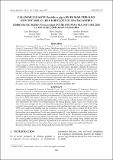Por favor, use este identificador para citar o enlazar este ítem:
https://hdl.handle.net/20.500.12958/3439| Título : | Calamar gigante Dosidicus gigas en el mar peruano. Nov-Dic 2015. Cr. 1511-12 BIC José Olaya Balandra |
| Otros títulos : | Jumbo flying squid Dosidicus gigas in the Peruvian sea. Nov-Dec 2015. Cr. 1511- 12 R/V Jose Olaya Balandra |
| Autor : | Mariátegui Rosales, Luis Sanjinez Alvites, Maria Nelly Blaskovic' Huayta, Verónica Tafur Jiménez, Ricardo Tello Alejandro, Enrique Elliott Rodríguez, Walter Calderón, Wuilliam Chacón Nieto, Germán Aldana J., Leonardo Correa Acosta, Jonathan Yamashiro Guinoza, Carmen |
| Palabras clave : | Dosidicus gigas;Calamar gigante;Cruceros de investigación;Moluscos |
| Fecha de publicación : | jun-2020 |
| Editorial : | Instituto del Mar del Perú |
| Citación : | Inf Inst Mar Perú 47(2), 2020, p. 200-226 |
| Citación : | Informe IMARPE;47(2), 2020 |
| Resumen : | El Crucero de Investigación del calamar gigante se desarrolló del 14 de noviembre al 08 de diciembre 2015, desde 05°S (Paita) hasta 18°30’S (frente a Ilo) y longitudinalmente de 72° a 82°W. Se evaluó el índice de abundancia relativa utilizando poteras de distintos tamaños, red larva cátcher y red de arrastre pelágica, también se determinó las interrelaciones del recurso con el ambiente marino. El CPUE varió en relación a la zona de pesca, mayores valores se encontraron
en la zona del triángulo exterior y el área en la que opera la flota industrial de bandera extranjera. En
60 operaciones con línea de mano con potera y red de arrastre de media agua se capturó 982,56 kg de
calamar gigante, el 96,9% fue con línea y el resto con red. Se capturó 369,92 kg de otras especies, el 92,5%
correspondió a red de arrastre pelágica. La variación de talla estuvo asociada al tamaño de potera; en
la captura con línea de mano la talla fluctuó entre 17 y 99 cm de longitud del manto (LM) obteniéndose
diferencias de acuerdo al tamaño de la potera; mientras que con la red de arrastre el rango de talla
fue de 1 a 26 cm LM. En las hembras predominaron estadios inmaduros (42,3%) y en desove (48,1%)
y en los machos inmaduros (33,3%) y en evacuación (63,3%). Las condiciones oceanográficas mostraron
características atípicas para la estación de primavera siendo más cálidas respecto al patrón climatológico.
La mayor presencia de paralarvas se observó en la zona norte, asociado al ambiente cálido de la zona,
donde también se obtuvo mayor presencia de juveniles de cefalópodos. ABSTRACT: From November 14 to December 8, 2015, the Jumbo Flying Squid Research Cruise took place between 05°S (Paita) and 18°30’S (off Ilo) and longitudinally from 72° to 82°W. The relative abundance index was evaluated by using different size jiggers, net larva catcher, and pelagic trawls, and the interrelationships of the resource with the marine environment were also determined. The CPUE varied depending on the fishing ground, higher values were found in the area of the outer triangle and the area where the foreign-flag industrial fleet operates. A total of 982.56 kg of jumbo flying squid were caught in 60 operations with handline with jigger and midwater trawl, only 96.9% were caught with handline and the remaining with the net. Other species totaled 369.92 kg, 92.5% and were caught with pelagic trawls. Size variation was associated with the size of the jigger; the size in the handline catch ranged from 17 to 99 cm in mantle length (ML), with differences according to the size of the jigger; while with the trawl the size varied between 1 and 26 cm ML. The females were predominantly immature (42.3%) and spawning (48.1%) and the males were immature (33.3%) and in evacuation (63.3%). The oceanographic conditions presented atypical characteristics for the spring, being warmer than the weather pattern. The greatest presence of paralarvae was observed in the northern zone, associated with the warm environment of the area, where there was also a greater presence of juvenile cephalopods. |
| URI : | https://hdl.handle.net/20.500.12958/3439 |
| ISSN : | 0378-7702 |
| Aparece en las colecciones: | Informe vol. 47(2) 2020 |
Ficheros en este ítem:
| Fichero | Descripción | Tamaño | Formato | |
|---|---|---|---|---|
| Informe 47-2 articulo2.pdf | 2,35 MB | Adobe PDF |  Visualizar/Abrir |
Este ítem está sujeto a una licencia Creative Commons Licencia Creative Commons

